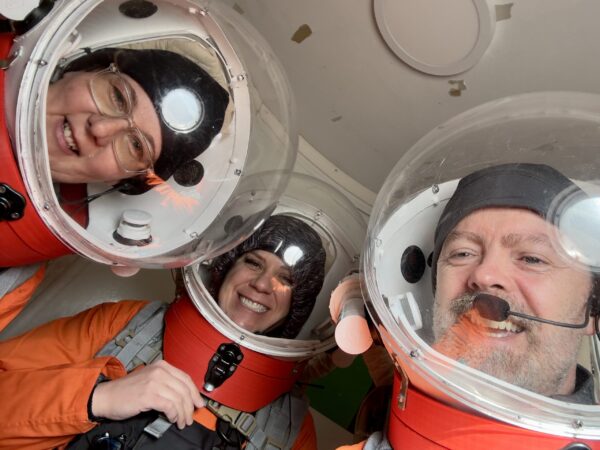HANKSVILLE, UT — Living in cramped quarters, eating freeze-dried “astronaut foods,” going on long EVAs (space walks) in space suits, and collecting science samples just like astronauts on the red planet might in future missions. These are the experiences of six teachers who recently returned from the Mars Desert Research Station (MDRS) in south-central Utah. The simulated Mars mission took place in Utah’s high deserts as a part of a NASA-funded program The Mars Society calls Spaceward Bound Utah.
The purpose of the program is to train K-12 teachers to engage students in inspiring and realistic activities that will guide them toward future careers in the space sciences. The program provides teachers with hands-on experience working with scientists conducting space-related research in a “Martian” field setting that closely mimics conditions that would be found on the red planet.
MDRS is a research facility that is designed to imitate an early research base on Mars. The campus includes a mock spacecraft designed to land on the surface with a greenhouse, science dome, and two observatories all connected by tunnels. Mock Extra Vehicular Mobility Units (EMUs), also known as space suits, are provided for extravehicular activities (EVAs), also known as spacewalks outside of the habitat. While participating in a simulated mission, crew members are expected to act like they are on Mars and are regularly reminded, “If you couldn’t do it on Mars, don’t do it in sim,” by the station Director and program PI, Dr. Shannon Rupert, and Assistant Director Sergii Iakymov, both of the Mars Society, the organization that owns and operates the station.
As humanity inches ever closer to the first boot prints on the Martian surface, the research conducted at Martian analogs like MDRS becomes ever more critical. At the same time, training the next generation of scientists, engineers, and astronauts who will make that landing possible becomes ever more urgent. That is why The Mars Society provides programs like Spaceward Bound. Teachers who participate in the program return to classrooms and school districts to magnify their experience, sharing it with many more teachers and students.
Teacher crews are selected for their diversity of experience and their potential reach in the education realm, among other criteria. Crew members are expected to collaborate both in the field to gather research data and in the creation of lesson plans that can be taken back to the classroom. The teacher cohort becomes a support group for the implementation of those lessons in classrooms and districts across the state and even around the world.
MDRS is a great place to have a Martian experience, get the creative juices flowing, and write a lesson plan. As a near-perfect geological analog of the Martian surface, MDRS gives a lot of opportunities for realistic “off-world” simulated experiences.
NOTICE: The Mars Desert Research Station is a private and active research facility. MDRS does not, at any time, offer tours nor are facilities open to visitors. People are allowed to pass the campus on designated roads. Please respect all signage and stay on designated roads. Please respect applicable BLM rules in the area and the privacy of researchers who are active on the property.
Quotes from Crew Members
Jen Carver-Hunter explained, “Spaceward Bound Utah’s integration of science, sim, and education provides an intense professional development experience for Utah teachers while fostering enthusiasm for space exploration and developing long-term collaborative relationships.”
Jen Jones stated, “The experience I had at MDRS drives home the realization that visiting Mars is not a far-future fantasy; it is a here-and-now reality, and we are preparing for it right now. As teachers, we will see someone land on Mars and our students will live in that future reality. I fully expect that at least one
of my students will be instrumental in sending humans to Mars. I tell them all the time that I want a personal invite to the launch or landing the first time they touch space.”
Amy Fullmer added, “My time at MDRS helped me see the depth of opportunities for students. Learning about and preparing for the future of humanity on Mars is a great way for students to develop talents in STEM. I want my students to be successful citizens and that comes from helping them develop skills, from the soft skills of communication and teamwork to critical thinking and problem-solving skills. Experiencing MDRS was like having a sandbox to display and test those skills. I learned how critically important they are.”
Dr. Jordan Chaves wrote, “I am amazed and intrigued at how human factors impact the crew and morale on MDRS missions. This is something that isn’t discussed a lot in space travel media content, but it is so important that our students know how to collaborate, work with a team, and build each other up! These soft skills are important in a lot of careers, including for astronauts on Mars!”
Jonathan Nalder wrote, “Spaceward Bound was an incredible chance for teachers to become ‘Edunauts’ and to experience a high-end research facility they wouldn’t normally have access to. This leads to them improving their teaching and thus directly impacting learners, encouraging them to aim for the stars.“
Dr. Jenny Sumsion expressed, “Our time at MDRS was the ultimate field trip! Classroom learning can include great simulations but the time we spent at this outpost was next level. Spaceward Bound gave me the opportunity to enrich my experience and increased my desire to be an advocate for science education. It was truly an otherworldly, immersive place that strengthened the reasons why we are teaching collaboration, problem-solving, and grit to our students.”
– Mars Desert Research Station
Feature image caption: Right to left Jen Jones, Amy Fullmer, and Jonathan Nalder take a selfie in the airlock as they wait for the simulated depressurization routine before exiting the habitation module. Courtesy Johnathan Nalder.
Shoutout to the awesome teachers along the Byway! Read more about one teacher’s award in math in Stacie Ekker Recognized Mather Teacher of the Month.

